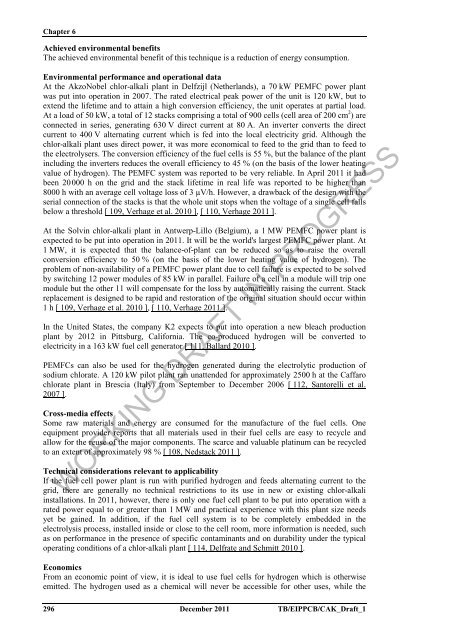(BAT) Reference Document for the Production of Chlor-alkali ...
(BAT) Reference Document for the Production of Chlor-alkali ...
(BAT) Reference Document for the Production of Chlor-alkali ...
Create successful ePaper yourself
Turn your PDF publications into a flip-book with our unique Google optimized e-Paper software.
Chapter 6<br />
Achieved environmental benefits<br />
The achieved environmental benefit <strong>of</strong> this technique is a reduction <strong>of</strong> energy consumption.<br />
Environmental per<strong>for</strong>mance and operational data<br />
At <strong>the</strong> AkzoNobel chlor-<strong>alkali</strong> plant in Delfzijl (Ne<strong>the</strong>rlands), a 70 kW PEMFC power plant<br />
was put into operation in 2007. The rated electrical peak power <strong>of</strong> <strong>the</strong> unit is 120 kW, but to<br />
extend <strong>the</strong> lifetime and to attain a high conversion efficiency, <strong>the</strong> unit operates at partial load.<br />
At a load <strong>of</strong> 50 kW, a total <strong>of</strong> 12 stacks comprising a total <strong>of</strong> 900 cells (cell area <strong>of</strong> 200 cm 2 ) are<br />
connected in series, generating 630 V direct current at 80 A. An inverter converts <strong>the</strong> direct<br />
current to 400 V alternating current which is fed into <strong>the</strong> local electricity grid. Although <strong>the</strong><br />
chlor-<strong>alkali</strong> plant uses direct power, it was more economical to feed to <strong>the</strong> grid than to feed to<br />
<strong>the</strong> electrolysers. The conversion efficiency <strong>of</strong> <strong>the</strong> fuel cells is 55 %, but <strong>the</strong> balance <strong>of</strong> <strong>the</strong> plant<br />
including <strong>the</strong> inverters reduces <strong>the</strong> overall efficiency to 45 % (on <strong>the</strong> basis <strong>of</strong> <strong>the</strong> lower heating<br />
value <strong>of</strong> hydrogen). The PEMFC system was reported to be very reliable. In April 2011 it had<br />
been 20 000 h on <strong>the</strong> grid and <strong>the</strong> stack lifetime in real life was reported to be higher than<br />
8000 h with an average cell voltage loss <strong>of</strong> 3 ZV/h. However, a drawback <strong>of</strong> <strong>the</strong> design with <strong>the</strong><br />
serial connection <strong>of</strong> <strong>the</strong> stacks is that <strong>the</strong> whole unit stops when <strong>the</strong> voltage <strong>of</strong> a single cell falls<br />
below a threshold [ 109, Verhage et al. 2010 ], [ 110, Verhage 2011 ].<br />
At <strong>the</strong> Solvin chlor-<strong>alkali</strong> plant in Antwerp-Lillo (Belgium), a 1 MW PEMFC power plant is<br />
expected to be put into operation in 2011. It will be <strong>the</strong> world's largest PEMFC power plant. At<br />
1 MW, it is expected that <strong>the</strong> balance-<strong>of</strong>-plant can be reduced so as to raise <strong>the</strong> overall<br />
conversion efficiency to 50 % (on <strong>the</strong> basis <strong>of</strong> <strong>the</strong> lower heating value <strong>of</strong> hydrogen). The<br />
problem <strong>of</strong> non-availability <strong>of</strong> a PEMFC power plant due to cell failure is expected to be solved<br />
by switching 12 power modules <strong>of</strong> 85 kW in parallel. Failure <strong>of</strong> a cell in a module will trip one<br />
module but <strong>the</strong> o<strong>the</strong>r 11 will compensate <strong>for</strong> <strong>the</strong> loss by automatically raising <strong>the</strong> current. Stack<br />
replacement is designed to be rapid and restoration <strong>of</strong> <strong>the</strong> original situation should occur within<br />
1 h [ 109, Verhage et al. 2010 ], [ 110, Verhage 2011 ].<br />
In <strong>the</strong> United States, <strong>the</strong> company K2 expects to put into operation a new bleach production<br />
plant by 2012 in Pittsburg, Cali<strong>for</strong>nia. The co-produced hydrogen will be converted to<br />
electricity in a 163 kW fuel cell generator [ 111, Ballard 2010 ].<br />
PEMFCs can also be used <strong>for</strong> <strong>the</strong> hydrogen generated during <strong>the</strong> electrolytic production <strong>of</strong><br />
sodium chlorate. A 120 kW pilot plant ran unattended <strong>for</strong> approximately 2500 h at <strong>the</strong> Caffaro<br />
chlorate plant in Brescia (Italy) from September to December 2006 [ 112, Santorelli et al.<br />
2007 ].<br />
Cross-media effects<br />
Some raw materials and energy are consumed <strong>for</strong> <strong>the</strong> manufacture <strong>of</strong> <strong>the</strong> fuel cells. One<br />
equipment provider reports that all materials used in <strong>the</strong>ir fuel cells are easy to recycle and<br />
allow <strong>for</strong> <strong>the</strong> reuse <strong>of</strong> <strong>the</strong> major components. The scarce and valuable platinum can be recycled<br />
to an extent <strong>of</strong> approximately 98 % [ 108, Nedstack 2011 ].<br />
Technical considerations relevant to applicability<br />
If <strong>the</strong> fuel cell power plant is run with purified hydrogen and feeds alternating current to <strong>the</strong><br />
WORKING DRAFT IN PROGRESS<br />
grid, <strong>the</strong>re are generally no technical restrictions to its use in new or existing chlor-<strong>alkali</strong><br />
installations. In 2011, however, <strong>the</strong>re is only one fuel cell plant to be put into operation with a<br />
rated power equal to or greater than 1 MW and practical experience with this plant size needs<br />
yet be gained. In addition, if <strong>the</strong> fuel cell system is to be completely embedded in <strong>the</strong><br />
electrolysis process, installed inside or close to <strong>the</strong> cell room, more in<strong>for</strong>mation is needed, such<br />
as on per<strong>for</strong>mance in <strong>the</strong> presence <strong>of</strong> specific contaminants and on durability under <strong>the</strong> typical<br />
operating conditions <strong>of</strong> a chlor-<strong>alkali</strong> plant [ 114, Delfrate and Schmitt 2010 ].<br />
Economics<br />
From an economic point <strong>of</strong> view, it is ideal to use fuel cells <strong>for</strong> hydrogen which is o<strong>the</strong>rwise<br />
emitted. The hydrogen used as a chemical will never be accessible <strong>for</strong> o<strong>the</strong>r uses, while <strong>the</strong><br />
296 December 2011 TB/EIPPCB/CAK_Draft_1







